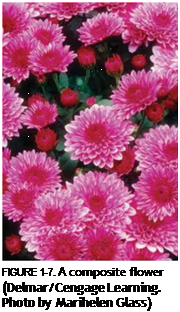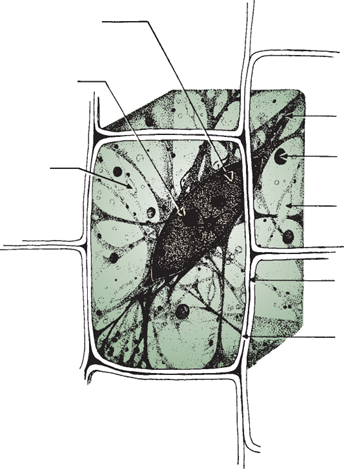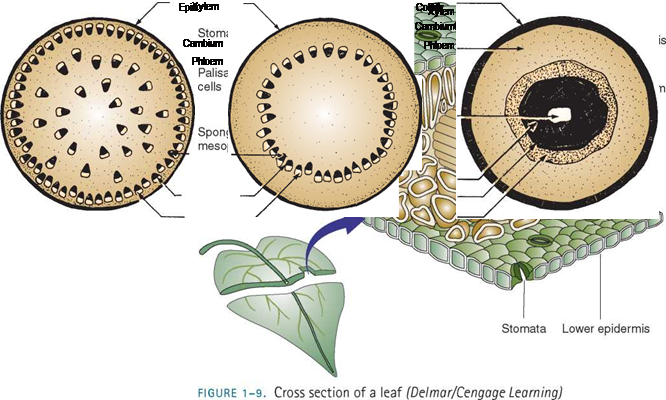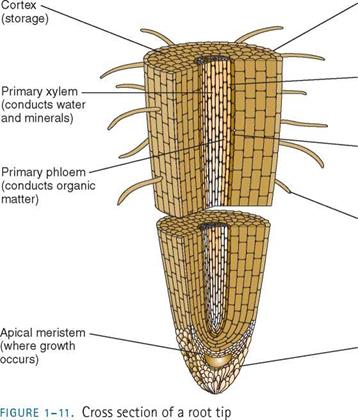
 All living organisms except viruses have the cell as their basic structural unit. A single plant part, such as a leaf, may be composed of millions of cells. The cells of plants may range in size from 1/25,000 of an inch to nearly 4/10 of an inch. Plant cells can best be visualized as threedimensional chambers which, when joined together, are responsible for the shape, size, appearance, and function of all the earth’s plants. Plants grow from seeds to maturity by the enlargement of existing cells and the production of new ones.
All living organisms except viruses have the cell as their basic structural unit. A single plant part, such as a leaf, may be composed of millions of cells. The cells of plants may range in size from 1/25,000 of an inch to nearly 4/10 of an inch. Plant cells can best be visualized as threedimensional chambers which, when joined together, are responsible for the shape, size, appearance, and function of all the earth’s plants. Plants grow from seeds to maturity by the enlargement of existing cells and the production of new ones.
All plant cells are basically alike (Figure 1-8). Nevertheless, leaves do not look like stems, and roots and flowers are equally different. Some parts of the plant photosynthesize, and other parts do not. Some parts are rigid, like stems, and other parts are pliable, like leaves. As cells group together, they become differentiated in their functions. Large groups of similar cells carrying on the same function are termed tissues. Groups of tissues make up the organs of plants (Figures 1-9, 1-10, and 1-11). From the diagrams, several facts should be noted.
The Cell
Tiny though they are, plant cells are not hollow like empty boxes. Each cell is comprised of a variety of components, and each component has

![]()

 Middle lamella (Cement the cells together)
Middle lamella (Cement the cells together)
Cell wall
(Nonliving layer; strengthens and supports)
 |
figure 1-ю. Cross sections of different types of plant stems (Delmar/Cengage Learning)
a vital role to play in the growth, reproduction, and differentiation of the cell (Figure 1-8).
• The cell wall is the foremost distinction between plant and animal cells, since animal cells lack walls. Usually multilayered, the cell wall has a primary wall on the outside, a secondary wall on the inside, and a cementing agent between them termed the middle lamella. The wall is composed of a matrix of carbohydrates reinforced by cellulose molecules arranged in long, rod-like structures.
![]()
|
|
|
|
|
|
|
|
|

As cells age, they acquire deposits of lignin (complex polymers)
within the carbohydrate matrix. The result is hardening of the cells,
which explains why plants become woody or stiffer as they grow and
age.
• The protoplast is the living matter of the cell.
• The nucleus is the vessel in the cell that contains the chromosomes, the nucleolus, and the nucleoplasm. The chromosomes carry the genes that direct heredity; the nucleolus is the site of ribosome production; and the nucleoplasm supports it all.
• Chloroplasts contain the chlorophyll pigment which is vital to photosynthesis.
• Cytoplasm is all of the living material in the cell other than the nucleus. (Cytoplasm + nucleus = the protoplast.)
• The vacuole is a cavity within the cytoplasm. It is lined with a membrane and filled with salts, various pigments, and organic materials that are collectively termed the cell sap.
• The plasma membrane surrounds the protoplast like a thin plastic bag, separating it from the cell wall. The membrane is semipermeable and controls what substances pass into and out of the cell.
• Cytoplasmic strands connect the protoplasts of adjacent cells, making the living material of the cells continuous within the plant.
• Mitochondria are specialized regions of the plant cell in which respiration occurs. They are enclosed by a double membrane, the innermost of which is folded like an accordion. That increases the surface area in which the chemical reactions of respiration can occur.
Although most plant cells contain the same components, they do not all serve the same function. Some remain simple (embryonic) and primarily divide and create new cells, permitting the plant to grow. Meristematic cells are such cells. They are concentrated at the tips of shoots and roots in most plants, which explains why those plants grow from their extreme ends (their apical meristems), not their bases. An obvious exception is the grasses, which grow at the base, not at the tips of their blades. Grassy monocots have their meristems located at their base, a convenient property that allows mowing without cutting off the growth cells.
Meristems also occur in other parts of the plant. Defined by their location; for example, axillary meristem (in the axils of leaves) and basal meristems (at the base or crown of a plant), they enable the plant to grow in places other than just the shoot.
Other cells, although originating from the meristematic cells, assume other roles in the plant as a result of their differentiation. Parenchyma cells are specialized cells comprising the cortex and pith tissues in stems and the spongy mesophyll tissue in leaves. Most present in leaves, flowers, and fruits, these cells allow the plant to heal its wounds, secrete and excrete materials, and store food. They are also the site of photosynthesis within the plant where they contain chloroplasts. Collenchyma cells are also specialized to provide plants the structural strength they need for support. Their cell walls are unevenly thick, permitting flexibility of the plants’ stems. Sclerenchyma cells have the thickest walls and are also involved in structural support of the plant when the cells assume the shape of long slender fibers. Sclerenchyma cells can also assume assorted other globular shapes, termed sclerids. Enmassed, sclerid cells form the hardest plant features such as the pits in cherries and peaches.
Stems
The transport of water, nutrients, and food materials between leaves and roots occurs in the vascular bundles.
The bundles constitute a system that reaches from the roots to the leaves, running in both directions. Water and mineral nutrients that enter the roots are carried upward to the leaves and other above-ground parts in the xylem. The xylem extends to all parts of the plant. It also offers structural support to plants, especially the woody trees and shrubs. As parts of the xylem mature, the tissue becomes nonliving, further contributing to the structural strength of the plant. The products resulting from the photosynthetic activity of the leaves are moved downward for storage in the roots and other tissues of the plant. Those products move in the part of the vascular system termed the phloem. Like the xylem, the phloem also contributes to the structural support of the plant. While it remains a living system, the tissue breaks down as it ages and is replaced by new tissue. Although likened to a hollow pipe, the phloem is actually
a linkage of elongated specialized cells, sieve elements, that conduct the food produced during photosynthesis to other parts of the plant.
There are two types of stems, defined by how their vascular tissues are arranged. Monocotyledons (monocots) are plants that have one cotyledon (seed leaf), while dicotyledons (dicots) have two cotyledons. Figure 1-10 illustrates how the stems of monocots and dicots differ in the arrangement of their vascular bundles.
Stems increase in diameter due to the activity of the cambium tissue that produces the xylem and phloem.
Because the stem is the major pipeline connecting the roots to the rest of the plant, it is logical that it serves as the site for the initiation of leaves and buds. The node is the location on a stem where a bud is initiated. The buds may develop into leaves or flowers. Some buds contain both leaves and flowers. The space between nodes is termed the internode. A further discussion of the location of buds as a means of identifying certain plants is included in Chapter 2.
Some stems don’t look like stems at all. Instead they function mainly as food storage structures in the form of corms, bulbs, tubers, rhizomes, and stolons. Many familiar flowers, grasses, and vegetables have these unusual stem types.
Leaves
Where the vascular tissues extend into leaves, they form a network of veins. The pattern of the veins (venation) is important in the classification and identification of many plants.
Gaseous exchange between the air outside the plant and the intercellular spaces inside the plant occurs through pores termed stomata or stomates (singular stomate). The plant loses water vapor through the stomata when they are open. That water loss is known as transpiration. When the stomata are closed, transpiration is reduced (Figure 1-9).
The upper and lower epidermis are covered by a waxy cuticle (not shown), which keeps the leaf basically impermeable to water and helps some plants retain internal moisture.
Leaf Color
Plant color in general, and leaf color in particular, results from the presence of pigments within the cells. In the majority of higher plants, including the ornamentals, chlorophyll is the pigment in greatest abundance. That is why most living, nondormant plants appear green. Other pigments are present in plants, however. Xanthophyll (bright yellow), carotene (orange), and anthocyanins (red) are pigments that occasionally dominate in plants such as the coleus or in the blossoms of most plants, but they usually await the aging of the leaf and the loss of the chlorophyll pigment to reveal their presence.
Roots
The root elongates in the region of the apical meristem. That is the region where the cells are most actively dividing. The apical meristem is protected by the root cap as the root presses through the soil.
As important as the apical meristematic region is to the growth of roots, it is not the area of the most rapid water and nutrient absorption. Rather, it is in the area of the root hairs where the fastest absorption occurs. Very little water or nutrient absorption occurs at the tips of roots or in older roots. It is the root hairs that number in the thousands and are only a cell in thickness that amplify the absorbing surface area of a plant’s root system (Figure 1-11).
Seeds
The Gymnosperms and Angiosperms are seed-bearing plants. A seed is a miniature plant. It develops through the sexual reproduction process and is initially dormant. It awaits the provision of proper environmental conditions that permit it to germinate.
The miniature plant is termed an embryo. It is enclosed by a seed coat if it has two cotyledons, or by a pericarp if it has only one cotyledon. As noted previously, plants that produce one or two cotyledons are termed monocots or dicots, respectively. Cotyledons supply nutrients to the embryo until it can begin photosynthesizing to allow its further development.



